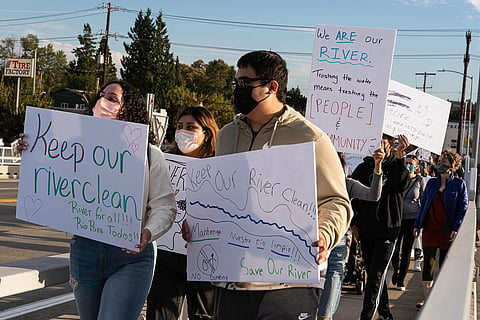OPINION | Pollution in the Duwamish River Is Causing Sickness in People and Marine Animals. Here's How You Can Help.
by Jessica Tedeschi
Many of our South Seattle neighbors are living with toxic hazardous waste. People living in the Georgetown/Duwamish River area of Seattle are being subjected to polluted waterways from years of industrial contaminants being dumped into the ground in and around the Duwamish River. This pollution causes serious health problems and gives rise to health disparities among impoverished Indigenous and non-Indigenous residents. Fish have been found with recordable deformities and cancer-causing chemicals attached to their DNA, and residents are becoming ill because of toxic chemicals in the water.
After years of pollution, there are now 41 combined contaminants in the Duwamish River, including PCBs, cPAHs, arsenic, dioxins, and furans. Spills and toxic leaks from historical gas station sites and historical dry cleaner sites have left pollutants seeping into our Duwamish waterway through the ground.
Pollution has long been documented in the Georgetown/Duwamish River area, the sacred ground once honored and cared for by the local Duwamish, Muckleshoot, and Suquamish tribes. When the government acquired the land through broken treaties, it was used primarily for industrial production, transforming this once pristine natural resource into a dumping ground. Studies have shown that in addition to illness caused by drinking the water, recreational use of contaminated water leads to unintentionally ingesting contaminants through splashing or falling into unsafe toxic water.
Fish from the Duwamish River were found to have DNA adducts, which are segments of DNA bound to cancer-causing chemicals; hepatic lesions — cell abnormalities within the liver; reduced growth; and impaired immune function. Indigenous people rely on fishing the Duwamish River for food and cultural practices. But when people eat these contaminated fish, they ingest the pollutants that have been dumped into the water. Eating toxic fish is known to cause cancer in humans. With the cost of living — especially the cost of groceries — skyrocketing, we can presume the need for natural resources has greatly increased, which in turn increases the exposure to toxins.
Residents of the Georgetown/Duwamish River area face catastrophic illnesses due to pollution. Studies show that people in the area are susceptible to diabetes, heart disease, and cancer at disproportionate rates and have a lower life expectancy than Seattleites in other neighborhoods. In fact, these residents' life expectancy is eight years shorter than the Seattle/King County average.
There is a clear correlation between illnesses and environmental toxins. Researchers even have a classification for the toxins that are likely contributing to diabetes — diabetogenic. Some of these toxins include polychlorinated biphenyls (PCBs) — a group of manmade chemicals used as coolants and lubricants in transformers and other electrical equipment that alter thyroid and reproductive function, cause increased risk of cardiovascular and liver disease, and contribute to diabetes; arsenic, a naturally occurring element known to cause cancer; carcinogenic polycyclic aromatic hydrocarbons (cPAHs), which are combinations of seven PAHs classified as carcinogens (agents capable of causing cancer); dioxins, which are highly toxic and are linked to reproductive and developmental issues, damage to immune systems, hormone issues, and cancer; and furans which are linked to a skin condition called chloracne, liver problems, and elevated blood lipids. Because of the exposure, residents are experiencing toxic living environments and this is shown in the overwhelming data documenting overall poor health.
But community groups are working to clean up the area. Many organizations have stepped up and taken on the huge task of removing the hazardous waste. These people are longtime community members who care about their home. Additionally, the Washington State Department of Ecology has made continued efforts to clean up the waste sites in the lower Duwamish waterway. However, these clean-up efforts have not happened fast enough to ensure the health of the residents.
There is no reason that our South Seattle neighbors should live amongst toxic hazardous waste. Residents in the Georgetown/Duwamish River area of Seattle are living near waterways contaminated from years of pollution that are causing adverse health effects in humans and marine animals, and there is no good reason this should be true.
So, what can you do? Join in with those who are working to clean up this toxic hazardous waste. Let's work to take care of this earth we are blessed to live on, so she can continue to take care of us.
The South Seattle Emerald is committed to holding space for a variety of viewpoints within our community, with the understanding that differing perspectives do not negate mutual respect amongst community members.
The opinions, beliefs, and viewpoints expressed by the contributors on this website do not necessarily reflect the opinions, beliefs, and viewpoints of the Emerald or official policies of the Emerald.
Jessica Tedeschi is a health studies major at the University of Washington, Bothell.
📸 Featured Image: Community members chanted "Clean the river!" as they marched across the South Park Bridge during a Sept. 24, 2021, rally protesting the EPA's proposed changes to the cleanup of the Duwamish River. (Photo: Ronnie Estoque)
Before you move on to the next story …
The South Seattle Emerald™ is brought to you by Rainmakers. Rainmakers give recurring gifts at any amount. With around 1,000 Rainmakers, the Emerald™ is truly community-driven local media. Help us keep BIPOC-led media free and accessible.
If just half of our readers signed up to give $6 a month, we wouldn't have to fundraise for the rest of the year. Small amounts make a difference.
We cannot do this work without you. Become a Rainmaker today!
Help keep BIPOC-led, community-powered journalism free — become a Rainmaker today.


